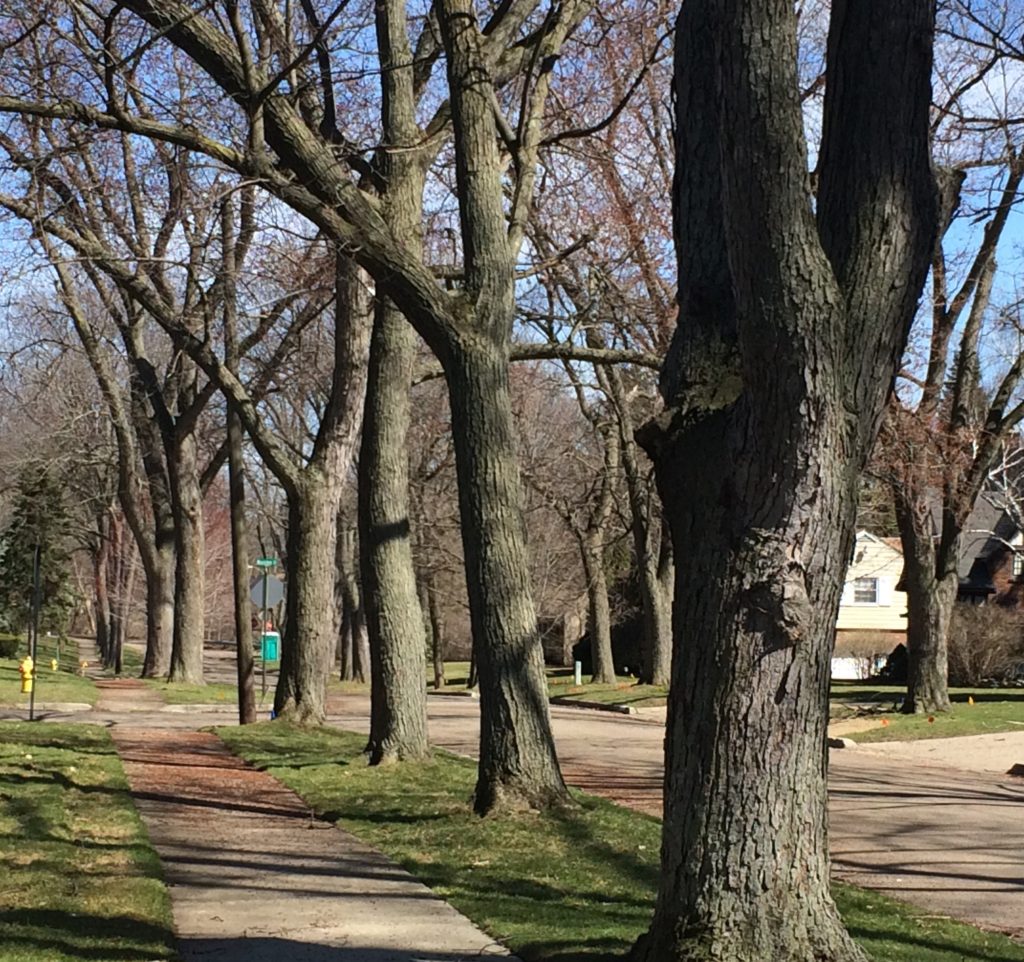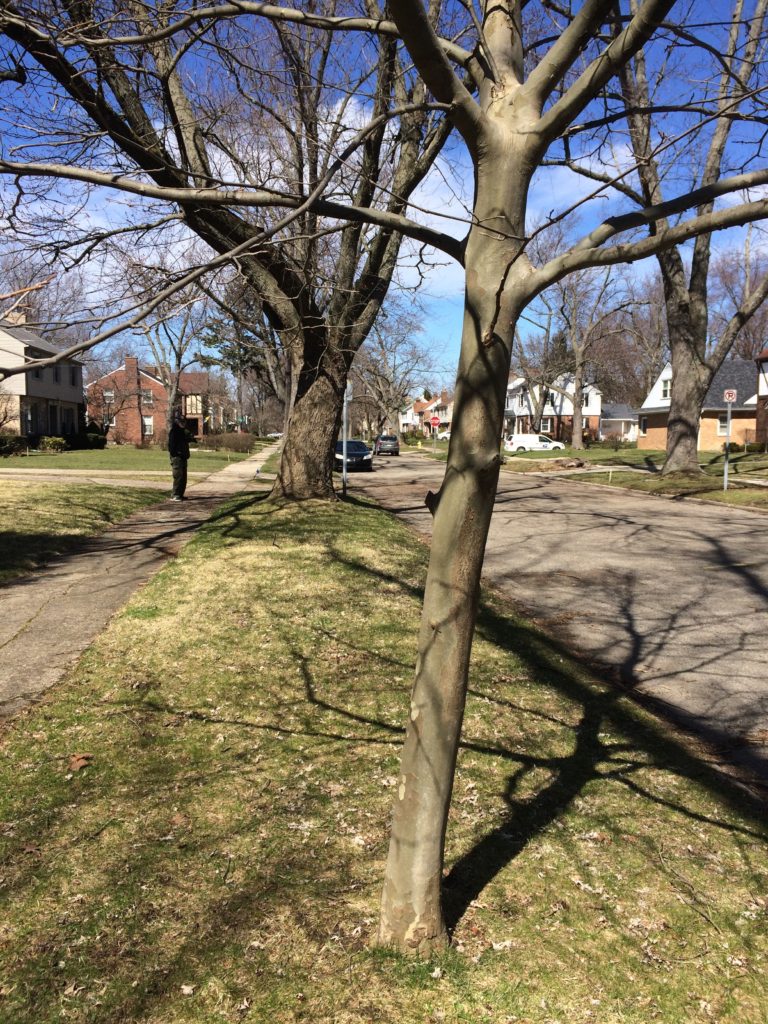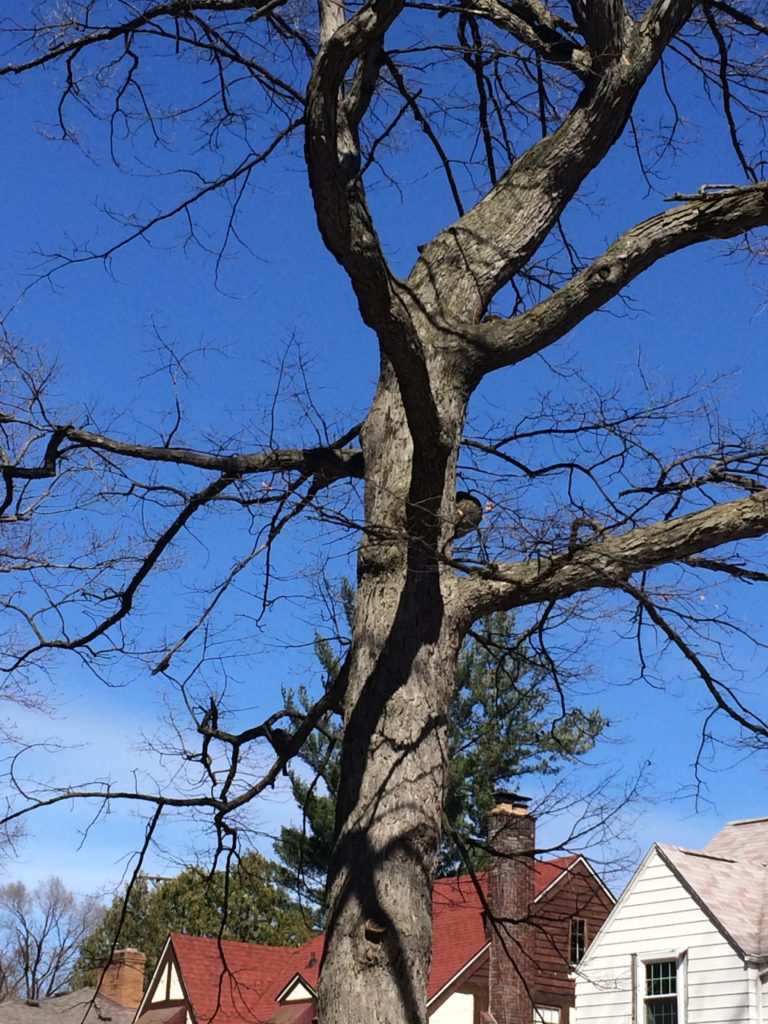By Jan Worth-Nelson
Members of the College Cultural Neighborhood Association, many of whom love their venerable green canopies, recently raised $4,000 in a matter of days to buy saplings to replace the 180 trees cut down by the city on parkways in their neighborhood last year. They have a plan in place for volunteers to put in the trees.
But so far, the city is denying permits to plant them.
Mike Keeler, president of the CCNA, voiced exasperation Friday and said time is running out to order the trees and get them in the ground this spring.

Silver maples lined up in the parkway on Linwood Street. (Photo by Jan Worth-Nelson)
He said the group was told by Betty Wideman, the city’s head of street maintenance, that the reason for the permit denial was that even though the CCNA is offering to order, pay for and plant replacement trees, the city does not have funds to maintain them.
Repeated calls to Wideman’s office by EVM to confirm the reasoning for the denial have been unsuccessful so far because her voice mailbox was full.
However, Monica Galloway, city councilwoman representing the Seventh Ward including the College Cultural neighborhood, one of the city’s most affluent, confirmed Wideman’s position.
Galloway said the proposal from the CCNA was a great idea, but that her constituents should try to understand the limits of the city’s finances and the need to address the needs of all 90,000 city residents, not just one neighborhood.
“What the city is trying to say is that they [the replacement trees] will be city property — and the city can’t ensure that there will be proper maintenance. Until they can figure that out, we really can’t go ahead. It’s unfortunate that Mike Keeler can’t seem to understand that perspective,” Galloway said. “What the College Cultural neighborhood is experiencing is unfortunate, but the city is in financial crisis.”

This London plane tree, in the sycamore family, was planted by Mike Keeler on Maxine Street about 15 years ago in the parkway, back when the city granted permission. It is healthy and about a foot in diameter. (Photo by Jan Worth-Nelson)
Keeler, a trained wildlife biologist and Sierra Club activist, said the CCNA has planted 170 replacement trees in the neighborhood over the past 15 years, always with city permission, and he doesn’t understand the current turnabout. He said he has a supplier ready to sell him 30 trees right now at what he considers to be a competitive price, and could get a selection of five choice varieties — Kentucky coffee trees, river birches, bald cypresses, tulip trees and sycamores — if the order is placed next week.
But demand for the trees is great in the planting season, and the order depends on timing. Keeler said it is exceptionally frustrating to have the funds available but to be stopped from proceeding.
“Please give the city time to figure it out,” Galloway said. “I’m trying to be as supportive as I can, but we are responsible for every homeowner in the city. We all live here. We all know that the funding in this community is lacking, and there’s has been a downsizing of every department at city hall.”
The city once had a forestry department with several full-time staff, but those positions and that department are long gone, along with funding to support them.
Keeler and others have been attempting for months to respond to the abrupt removals of the trees last year and to try to preserve the neighborhood’s canopies. Much of their ire has been directed to the Genesee Conservation District, an elected state body which acts as a coordinating partner with the city for urban forestry management. CCNA members have accused the GCD of leaning more towards cutting down rather than preserving trees and not communicating with residents, among other matters.
Conservation District spokespersons have said the removals were part of an urban forestry plan developed by a consultant in 2015, after a study inventoried ostensibly every one of the 30,000 trees in the city’s parkway — the space between the street and the sidewalk. CCNA representatives have criticized both the implementation methods and criteria for the removals.
A further complication is that GCD officials say there is little money in their current budget for tree replacements. GCD administrator Angela Warren has said in several meetings that there is enough only to replace 100 trees a year throughout the whole city.
The CCNA developed a list of nine recommendations for what its members believe would be improved GCD practice. Those recommendations were accepted and approved by the GCD board at a recent meeting and, Keeler said, were positively received by the City Council as well. But so far, Keeler said, there has been little evidence that the GCD is putting the recommendations into effect. He said the council’s response at a March 23 meeting was encouraging, but that the latest development has thrown CCNA tree advocates back into exasperation with the city and stymied what they thought was a fair solution backed by widespread neighborhood support.
“Most of us are going to be dead before we get any shade from the new trees,” Keeler said. “It’s not about us. We’re trying to make good for the future.”

Many CCN residents say they are fond of the craggy look of the old maples of their neighborhood, even without leaves in early spring. (Photo by Jan Worth-Nelson)
CCNA members and Galloway tentatively explored the possibility that individual homeowners might sign waivers taking on responsibility for the replacement trees planted at their addresses, in lieu of city management. That proposal has been informally forwarded to the city’s legal department for consideration, but Galloway said she is not confident it’s a good idea.
The CCNA had hoped and asserted that the replacements would improve future prospects for the urban forest by planting sets of trees every year, so that they would not all age out at the same time, and improving diversity by introducing a range of species. Many of the trees cut down over the past year were silver maples, all planted at about the same time when the neighborhood homes were built in the late 1920’s and ’30s. Their life span is about 75 years, meaning many are dying off simultaneously. Others were ash trees, planted to replace elm die-off from elm blight, then lost to the ash borer epidemic of the late 20th century.
EVM editor Jan Worth-Nelson can be reached at janworth1118@gmail.com.


You must be logged in to post a comment.